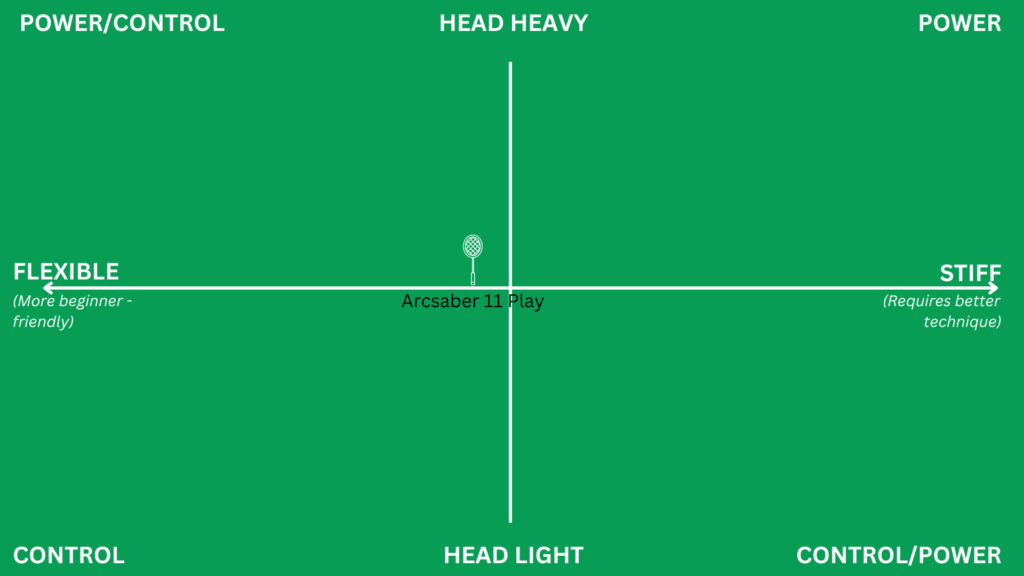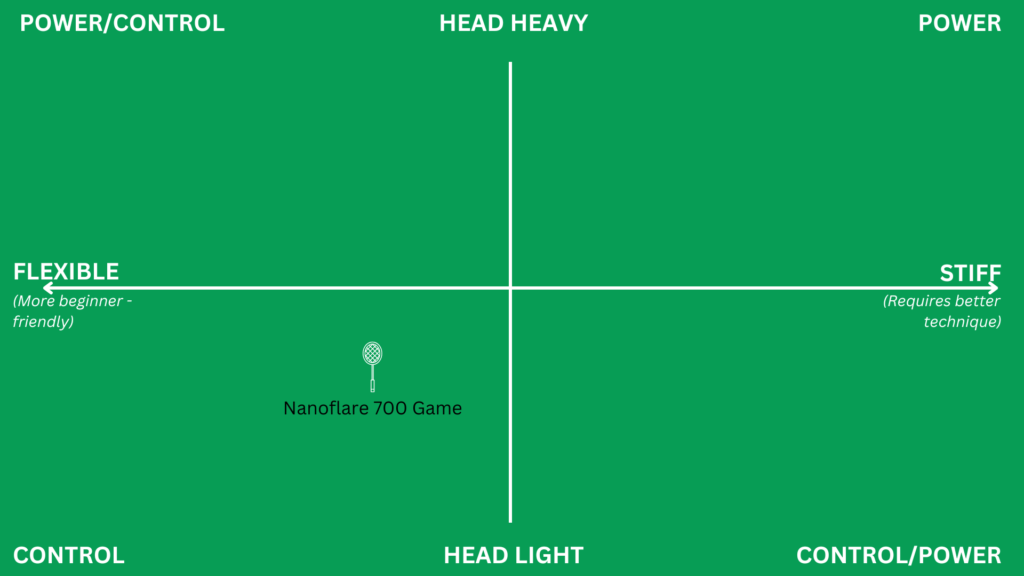THIS GUIDE HAS RECEIVED 7 UPDATES. THE LAST WAS MADE ON 15TH JUNE, 2025
- I've updated the racket recommendations
Let me begin with a counterintuitive point when looking for the best badminton rackets for beginners.
Before you develop hyper-focused and detailed workouts. Before you start thinking about entering national tournaments. Before you know your preferred playing style.
Before all that, you need a racket that matches your level and helps you have fun. That sounds like something out of a marketing department, but you’ll see a real difference in the power and ability to send good shots over the net by using a racket built for your level.
In this guide, I’ll show you how to find the best badminton rackets for beginners even if you’re not a racket-geek and just want something that looks as fresh as Jake in Brooklyn Nine-Nine!

As we dive into each of the rackets, I’ll show you some performance metrics so you’ll get a sense of how they are different, but feel free to skip that if you don’t care (I won’t tell anyone).
But before we do, let me share one simple metric you can use to recognize the rackets that are relevant for beginners when you’re browsing the racket jungle.
How do I choose a good badminton racket as a beginner?
The world’s producers of badminton rackets have less than ideal information about their products.
You enter a jungle of styles, brands, and designs, but generally, you want to find a racket that’s rewarding when you do well and (only) moderately punishing when you mess up.
It should be a racket that gives you an extra edge and not something you might find in a shed at a beach house with the precision of a drunk driver and the weight of a sledgehammer.
To cut through the brush of this jungle and find that balance of a good beginner badminton racket that’s fun to play with and nudges you to get better, you need to consider the following:
- Technique
- Racket difficulty
- Your assumption of being able to exploit intricate design differences in top-quality rackets (hint: you won’t)
- A few important racket factors
Let’s get something straight. All beginners lack technique (in all areas).
I’m not saying this to get you down. It’s just to say you need to keep in mind that there is no substitute for training if you want to get better – no racket will ever change that for you.
However, a racket that fits your level can make things a lot more fun, and this is where you can really start to narrow your options down.
- Rackets tested for this guide: 16
- Hours testing rackets on court: 160+ hours
- Updated: 20. September 2025
One massive influence on racket difficulty
Right away, you should eliminate 80% of rackets — they are a waste of your time because they’re out of your league.
I have a simple method to trim it down that you can use anywhere, and it works whether you shop online or go down to your local badminton store.
I focus on just one factor: racket flexibility.
My best advice is to stay away from stiff rackets or even those that are in the medium range.
The problem beginners have with rackets that aren’t very flexible is that they make it much harder to generate power.
At the same time, stiffer rackets focus more on the control aspect of the game (you’ll want to focus on this when you get better), and they generally require a higher skill level and consistent technique to strike good shots.
On the other hand, more flexible rackets offer you a power boost to strike fast shuttles even when you don’t hit them with the optimal angle and timing.
As a beginner, your technique simply won’t be good enough to manage stiffer rackets or tap into the control benefits they offer.
The big takeaway is that you’ll be fighting an uphill battle with little success in your game if your racket is too advanced.
With this factor, we can create a racket matrix that paired with attacking rackets (head heavy weight balance) or defensive rackets (head light), makes it easy to see how beginner rackets compare.

The highlighted area is where you’ll find a good beginner badminton racket. You’ll notice how this instantly eliminates all rackets that aren’t highly flexible.
Most producers will rank their rackets on a similar scale of flexibility, so you can easily filter for this criteria. Keep in mind that this is a simplified explanation as each racket brand sometimes categorizes them slightly differently depending on how they measure it.
You might not realize it now, but this saves you a lot of time (and potentially money) when deciding on a racket.
With that simple technique, it’s time to look at some rackets. You and I will look at power rackets, good-looking rackets, all-arounders, and options if you get tired fast.
For any racket you get, I recommend getting it restrung as most rackets come with weak strings and at low tension.
Let’s dive in.
Hey fellow badminton player,
I include links to buy the gear I review and if you do, the store pays me a small commission. That doesn’t change your price and you’ll get more play-tested gear as a result, but I thought it was fair to let you know.
As an Amazon Associate, I earn from qualifying purchases.
I appreciate your support,
Aske
Overview: the 3 best badminton rackets for beginners
1. The best all-around racket for doubles: Yonex Arcsaber 11 Play (~$55-$75 on Amazon)
3. The “I-get-tired-really-fast” racket: Yonex Nanoflare 700 Game (~$100-$125 on Amazon)
Table of Contents
Deep dive: the best badminton rackets for beginners
If you’d like to compare the rackets overall, here’s a simple racket matrix that shows how the rackets compare based on two performance metrics: flexibility and head heaviness.

1. The best all around beginner racket for doubles: Yonex Arcsaber 11 Play

I’ve been playing with the Arcsaber 11 Play for a long time and I like how versatile it is all around the court.
It’s fairly fast in doubles defense, pretty good in midcourt duels and shots, and around the net. It’s also fairly easy for beginner players to get used to and has a reasonable amount of power without it being so much that it becomes a disadvantage in other areas of the game.
Generating a ton of power without much work is probably the most tricky thing about this racket, which is why some players might find it difficult in singles games.
Read my in-depth review of the Arcsaber 11 Play here.
2. The best racket for both singles and doubles games: Yonex Astrox 88 Play

I’ve previously recommended the Astrox 99 Play as the best power-based badminton racket for beginners.
It’s still the most powerful one I’ve come across, but it’s not as good a fit if you’re brand new, as it will be when you’re a regular beginner player with more experience.
After testing the newer Yonex Astrox 88 Play 3rd gen (released in 2024), I bet that many new players will prefer it. It’s slightly easier to play with as the shaft is more flexible.
It has slightly less power, but I doubt you’ll notice the difference on powerful shots. Instead of being a full-on head heavy power machine, it’s slightly easier on the softer shots that happens a lot in beginner games.
That makes it feel a touch faster and less tiring to play with during longer sessions, but I did find it more fatiguing than my usual racket during games where I had to use attacking overhead shots a lot (my usual racket is also power-based, but less so than the Astrox 88 Play).
The Yonex Astrox 88 Play will be a good choice for beginners playing mostly singles or mixing singles and doubles games. It’s not the easiest racket on controlled shots at the front court, but it works well at the rearcourt when you need that extra power to get out of trouble or send a winner in the floor.
You can find my review after testing the Yonex Astrox 88 Play on court for 10 hours here.
3. The “I-get-tired-really-fast” racket: Yonex Nanoflare 700 Game

I previously recommended Yonex’s Nanoflare 1000, but after testing the brand new Nanoflare 700 Game, I’ve found it easier to play with without having to spend a bunch of time getting used to it.
Both rackets are marketed in the head light category, which makes them challenging to use for most beginner players during singles games, as they don’t offer any help generating power.
Power is especially handy when you’re in trouble and under pressure at the rearcourt, since you’ll need good technique to keep up while producing enough power to change the tables on your opponent.
I found that the Nanoflare 1000 series takes a while to get used to (and actually felt like it’s leaning towards being head heavy, meaning tiring during longer sessions for some players), whereas the Nanoflare 700 Game is much easier to get started with if you’re new to badminton.
It’s marketed to intermediate players, but after testing it on court for ten hours, I’ve found that it’s well-suited for both players at the beginner and low-intermediate level so you can grow with the racket as your skills improve.
That’s due to its highly flexible nature, which helps you with timing when hitting the shuttle. For beginner players, this is the most important thing to focus on when selecting your racket.
The Yonex Nanoflare 700 Game is crazy fast and fun in defense — I found myself returning attacks I didn’t expect with my normal racket. This tends to be the case with head light rackets, which is handy if you find yourself getting fatigued in your shoulder or arm while playing.
Not even the best badminton rackets are perfect. While this one is marketed as good for clear shots, I didn’t find that particularly easy when under pressure and you’ll struggle to generate power as easily as with more powerful rackets. That’s just the nature of this category of rackets.
If the Game-edition isn’t available, consider the Play-edition as it comes with similar specs and is more affordable (full disclosure, though, I haven’t tested the Play on court, only the Game-edition).
Dive into the full Nanoflare 700 Game review here.
Summary of the best badminton rackets for beginners

You’ll develop a lot as a beginner, so my advice is to think about what you find the most fun when playing badminton (i.e. which shot or part of the game) and think about how the best rackets can impact that, if at all.
Fun is the keyword here because you might be in a completely different mindset six months from now.
Maybe you’re good at hitting shuttles at your opponent that keep them on the defense and want some extra power to make your attacks even more deadly.
Maybe you’re very patient and like to extend rallies like Kodai Naraoka, test out a variety of shots, and want something that can help you out when you need to react quickly or change the pace.
Either way, these are simply preferences you need to decide on your own, and as long as you stay within the beginner range of the matrix, you won’t go completely wrong.
Frequently asked questions
The best way to choose a badminton racket for beginners is by looking for rackets that are highly flexible to help you if your technique and timing aren’t developed yet.
Other areas such as choosing a power-based, all-around, or fast racket come down to preferences as each one has its pros and cons.
4 comments
I went through a couple of blogs to choose what racket to buy as a beginner, and your blog is by far the easiest to understand to make a decision. Thanks a lot for putting together this amazing piece!
Thanks for the kind words, Tushti. I’m glad it helped
This is so helpful! One question. Would these recommendations change substantially for a kid in his early teens?
Good question, Tara. I figure it might – when I was that age, I played with a junior racket.
I remember the shaft being slightly shorter on those rackets, but it’s a long time ago so that might not be the case anymore. I’d look at yonex, victor, or lining’s junior racket categories in your case, but for your player, I imagine it might be around the time when you switch from junior rackets to the ‘normal ones’ in the guide